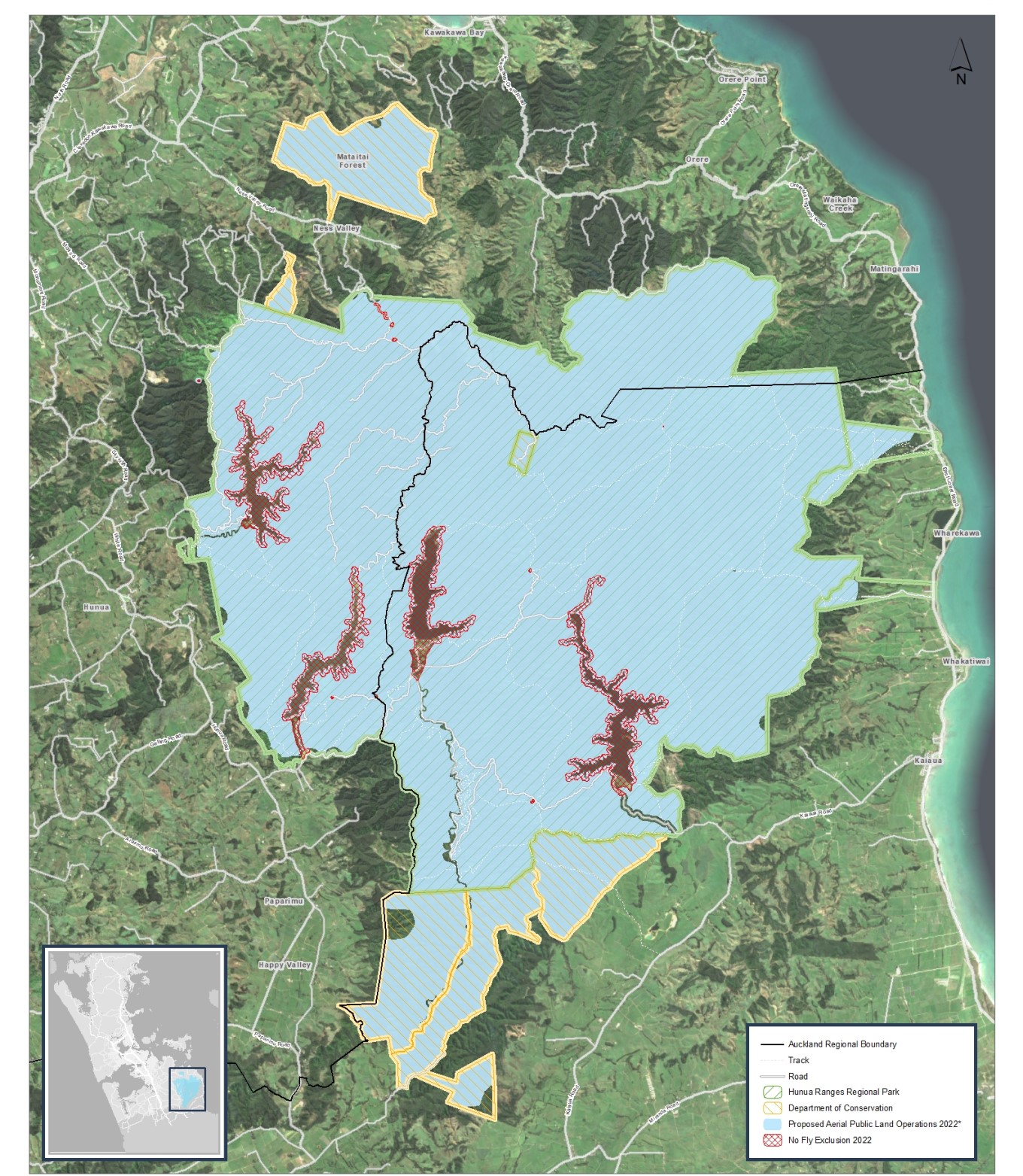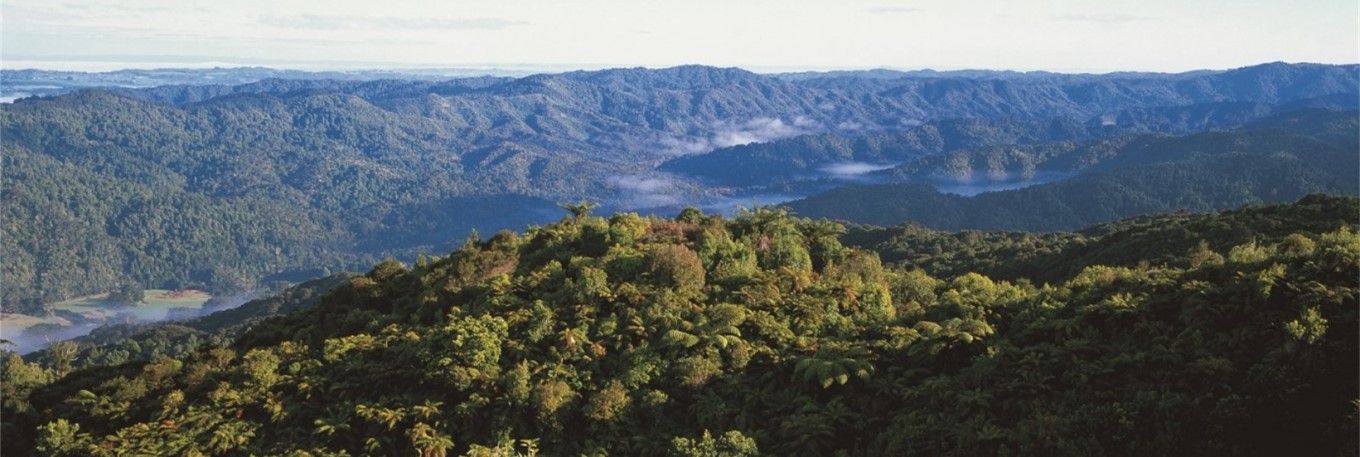The latest pest control operation in the Hunua Ranges parkland, neighbouring Department of Conservation (DOC) administered land reserves, and some private land, is close to getting underway.
From mid-August, the operational team will be closely watching the weather forecast to determine an optimal weather ‘window’ for the first stage of the operation.
The operation will begin with an aerial application of the non-toxic pre-feed bait across the roughly 21,500-hectare operational area. This will be closely followed by the application of baits containing 1080 (sodium fluoroacetate). The area will be treated in two separate blocks.

Auckland Council General Manager Environmental Services Rachel Kelleher says the operation will continue to protect the native wildlife that resides in the parkland.
“The Hunua Ranges is the largest area of native forest in the Auckland region and is home to many of Aotearoa’s threatened species.
“Together with the Department of Conservation and our iwi partners, our focus is on the protection of these species and our unique flora and fauna.
“Many of these native species are national taonga (treasures) and are vulnerable to introduced pests and diseases. However, through this collaborative work, significant gains and successes have been seen in the ranges over the last seven years, with many of our threatened species beginning to bounce back.
“This is particularly true for our native Kōkako which, after previously coming close to extinction, is once again thriving in the ranges, thanks in part to the 1080 operations carried out in 2015 and 2018.
“Since the last aerial pest control operation, we’ve continued to monitor the number of possums and rodents.
“While the data shows a slow possum reinvasion, rat densities have increased more significantly, putting the breeding success of our native birds, lizards and bats at risk once again.
“Despite the increase, numbers are still lower than they were before the 2015 and 2018 operations, which led to us making the decision to extend the period between operations from three to four years.
“Our aerial pest control operations are usually undertaken in either winter or early spring, when pests are hungry, visitor numbers are at their lowest and ahead of the key breeding time for a number of our native bird species but the exact timings are weather dependent.”
The pre-feed phase of the operation familiarises pest animals with the cereal baits, ahead of the baits containing 1080 (sodium fluoroacetate) being applied in the following weeks.
A satellite navigation system (GPS) and custom-designed bait applicators will be used to distribute bait (by helicopter) across the operational area.

Watercare chief operations officer Mark Bourne says the dams will be taken out of service ahead of the drop and will only be returned to service after a stringent water quality testing regime confirms no 1080 is detected in the water.
“Our dams in the Hunua Ranges are Auckland’s most important water sources, normally supplying about two thirds of Auckland’s water.
“As we’ve done in previous 1080 drops, we’ll be taking every precaution to protect the water stored in these dams.
“Auckland Council will ensure helicopters carrying bait will not fly over the reservoirs, and there will be setbacks from the margins of each reservoir. While the bait application is being carried out, the dams will be out of service and will only return once a comprehensive water sampling programme has been completed.”
The Hunua Ranges, Waharau and Whakatiwai regional parks and tracks within the neighbouring DOC reserves are closed while the pre-feed application is carried out and will reopen once it has been completed in a couple of days. When the toxic bait is applied, the parkland will remain closed to enable atrack clearance programme to be completed.
The operation is being undertaken by Auckland Council in partnership with DOC and is guided by the best practice use of 1080, set down by the government, and the conditions of permission granted to council by the Ministry of Health and Auckland Regional Public Health.
For more information, including park closure details, see www.aucklandcouncil.govt.nz/hunuaproject or phone 09 301 0101.
Important information
- Prefeed is a non-toxic cereal bait, used to get pest animals interested in the bait smell and taste and ensures the pests will be interested in and eat the toxic form of the bait when it is applied.
- 1080 is a deadly toxin – anyone visiting the ranges must observe warning signage and ensure that children do not touch or eat the toxic baits.
- Dogs are also at risk – if you must visit the ranges (where dogs are permitted), supervise your dog at all times and do not allow it to scavenge baits or carcasses. If you suspect your dog has been poisoned, induce vomiting and immediately go to a vet.
- The treatment area is around 21,5000 hectares and includes Hunua Ranges, Waharau and Whakatiwai regional parks; the Department of Conservation (DOC) administered Mataitai Forest Conservation Area, Papa Turoa Scenic Reserve, Whakatiri Scenic Reserve, Plows Road Conservation Area, Paparimu Conservation Area, Mangatawhiri Forest Conservation Area, Vining Scenic Reserve and Richard Sylvan Memorial Reserve and some adjoining private land.
- The area has been divided into two blocks which will be treated as follows:
- Application of non-toxic pre-feed bait to the whole operational area.
- Application of toxic bait (containing 1080) to block one (around 7-10 days after the pre-feed).
- Application of toxic bait to block two (there will be at least two days between the treatment of blocks one and two).
- The regional parks and the tracks on DOC land will be closed while bait is applied and until a rigorous track clearance programme has been completed.
- Helicopters will not fly over the public water reservoirs; setbacks are in place around the reservoirs and the supply from the reservoirs to the water treatment plant will be disconnected while each block is being treated. Reservoirs will not be returned to service until extensive monitoring has been carried out and the water has tested clear.
-
1080 operations have never contaminated drinking water in New Zealand. Extensive monitoring in water catchments that have been treated with 1080 show contamination is highly improbable when the current safety procedures are followed; this is backed by over 60 years of research which also shows 1080 operations don't affect waterways or aquatic life. www.doc.govt.nz/nature/pests-and-threats/methods-of-control/1080/


